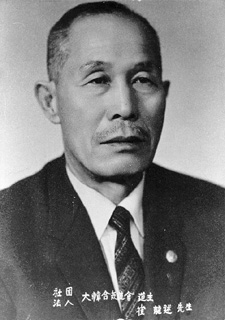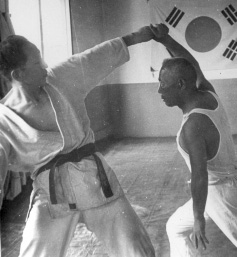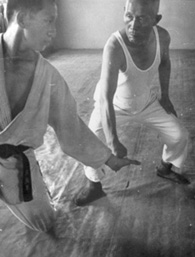|
|||
|
| -Countries |
| -Dictionary |
| -Federations |
| -M.A. Timeline |
| -Number System |
| -Styles |
| -Weapons |
| -Who's Who |
| -Updates |
| -Credits |
| -Stats |
| -Webmaster |
| Choi,Yong Sul (Sool)
The most widely known figure in the establishment of Hapkido is Choi Yong-Sul. There are many varying accounts of Choi's training in Japan and each particular story must be seen in the context of who is writing it. Much of Japanese history is written from an ethnocentric point of view , particularly in relation to Korean history. An example of this is the way Korean history was rewritten to the Japanese viewpoint during their brutal occupation of Korea from 1910 to 1945. During this period the Japanese tried to completely eliminate Korean thought, cultural arts and the foundation of traditional Korean martial arts as these posed a threat to their authority in an occupied land. Choi was born in 1904 at Chung Buk province in Korea. Some have said that he lost his parents at an early age. He is thought to have been in Japan by 1913 where he was a houseboy/servant, perhaps even the adopted son of Daito Ryu Aikijujitsu Grandmaster Takeda Sokaku. Martial arts historian Kim Jeong-yoon from Seoul says that after Choi was orphaned he was taken to Japan by a Japanese family. He then spent four years living in a temple before Takeda, a close friend of the abbot, took him in. Perhaps a more authoritative account comes from Suh Bok Sub, Choi's first student in Korea.
The head of the temple sent him to a friend of his by the name of Sokaku Takeda. Choi then cleaned Takeda's dojo for five years after which the master permitted him to learn aikijujitsu. In Suh Bok Subs interview he mentions Choi showing a photograph of Takeda to him and explaining to Suh that Takeda was his surrogate father. Many aikijujitsu exponents cannot accept the proposition that Choi, a Korean of low status in Japanese eyes could have possibly been taught or been close to Takeda. On the other hand Bernie Lau, an aikijujitsu researcher and instructor in February's 1987 edition of Black Belt commented that one of the more famous styles related to Daito Ryu is hapkido. In addition he makes the comment that Uyeshiba Morehei, aikido founder and a former student of Takeda, was so far below in social status than the other of Takeda's disciples that he could not even get a proper recommendation to study under Takeda. In Japan, Choi used the Japanese name Yoshida Tatsujutsu (or Tatujutu) since Japanese law at the time required everyone to use a Japanese name. Dr He-Young Kimm explains that on Choi's return to Taegue city in Korea in 1945 after the end of the Japanese occupation, a bag with his martial arts certificates and money was stolen. This has been confirmed by Suh Bok Sub who states that the bag was stolen at Younson train station after Choi returned to his home town of Yong Dong then decided to locate to Taegu city after he found no one to meet him at the train station. However there is no official records in the Daito Ryu to reflect the granting of a teaching certificate. Perhaps the reason no records exist is the fact that despite Choi's close relationship with Takeda he was not Japanese and therefore excluded from the records or that he did not pay any money for lessons and thus there is no registration of payment. Some claim that Choi's training was limited to just attending seminars. Regardless of these conjectures, Choi spent thirty two years in Japan off and on and his techniques reflect a definite link to Daito Ryu Aikijujitsu. Recent information has come to light in the form of a personal inyerview with Master Choi in 1982 in New York where he details the early years of his life. It seems he was abducted by the Japanese couple and then abandoned by them because he was being extremly difficult. This would account for him arriving at a Buddhist monastery because they often looked after orphans. Suh Bok Sub also mentions that by the time he returned to
Korea to stay after the war he was married to a Korean woman
and he had three daughters and a son. It seems he had travelled
from Japan to Korea previously and met his wife on one of these
visits. Jang In Mok We now come to a most interesting development that does not appear in much of the Hapkido literature. Still living today in Taegue city is Grandmaster Jang In Mok who also trained under Takeda Sokaku. Grandmaster Jang is eighty three years old which makes his birth year 1912. He has a scroll that lists his training record in the Daito Ryu. Even though Jang In Mok was born later than Choi Young Sool they were contemporaries in Japan studying under Takeda and they both returned to Taegue city in Korea in 1945. Jang is a doctor of oriental medicine and massage but also used to teach hapkido. As his career was mainly as a doctor he did not produce large numbers of students. Further research on Grandmaster Jang's early years in Japan is presently continuing and should he provide us with any further information it is certain to improve our resolution into this window of the past. From these two men who trained under Takeda Sokaku there has been a florescence of Hapkido masters who have spread the art around the world to the benefit of tens of thousands of students. As in any creative art each master has stamped their personal style and emphasis on their Hapkido. Dr Kim He Young documents many of the early Hapkido masters who trained under Choi Yong Sool. Among those listed are Suh Bok Sub, Kim Moo Wong (Shin Moo Kwan hapkido), Ji Han Jae (Sin Moo hapkido), Lee Joo Bang (founder of Hwarang Do), Suh In Hyuk (founder of Kuk Sool Won), Won Kwang Wha (Moo Sool Kwan Hapkido) and Kim Jung Yun (Han Pul). What is clear is that Suh Bok Sub was Choi Yong Sool's first student in Korea and his first lesson was on Sunday , February 22, 1948. At the present (1996) the two highest ranking students of Choi Yong Sool are Grandmaster Im Hyon Soo (9th degree) teaching in Taegu city, Korea, Grandmaster Chin il Chang (9th degree) in New York city and head of Hapkido (under Choi's system) . Grandmaster Ji Han Jae (10th Dan) heads his extensive Sin Moo Hapkido organization. Understanding these historical connections is an important component in any serious study of Hapkido and the martial arts journey. -- Grandmaster of Korean Hapkido, discussed his personal history
in an interview given during his visit to the United States
in June of 1982. Mr. Choi, under what circumstances did you come to
live in Japan? How old were you when you were abducted? What circumstances placed you in the home of Takeda,
Sokaku? In what city was the Buddhist temple that was your
home? In what area was Takeda, Sokaku’s home and dojang
(school) located? What was the nature of your training under Takeda,
Sokaku? Takeda was the teacher of the Japanese royal family.
Were you personally involved in teaching the royal family? Did you ever leave Japan with Master Takeda for any
exhibitions or teaching outside of Japan? What was your personal status on this tour? How many people were on the exhibition team and can
you recall the names of any of the participants? When you returned from Hawaii were there any significant
changes in your life? How was your life affected by the outbreak of World
War II? Why were you not drafted along with the others? How many separate techniques had Takeda, Sokaku developed
and mastered in his system? How many of these techniques have you personally mastered?
Do you know the circumstances of Takeda, Sokaku's death?
Why did he do that?
When did you return to Korea? Where in Korea did you settle?
|


 In
an interview with Michael Wollmershauser of Massachusetts in
1996 Suh Bok Sub stated that Choi had told him that he was born
into a very poor Korean family who lived close by to a candy
factory run by a Japanese couple. The couple took a liking to
Choi and, as his family could not afford him, they allowed the
couple to return to Japan with their son. This accords with
the Kim Jeong-yoon's account. As a Japanese couple took him
to Japan there was no problem Choi entering Japan. The couple
left Choi at a Buddhist temple so they could travel more widely
in Japan and so that Choi could be given an education. Apparently
Choi was not interested in schooling and was causing some minor
problems by fighting and having a lack of discipline.
In
an interview with Michael Wollmershauser of Massachusetts in
1996 Suh Bok Sub stated that Choi had told him that he was born
into a very poor Korean family who lived close by to a candy
factory run by a Japanese couple. The couple took a liking to
Choi and, as his family could not afford him, they allowed the
couple to return to Japan with their son. This accords with
the Kim Jeong-yoon's account. As a Japanese couple took him
to Japan there was no problem Choi entering Japan. The couple
left Choi at a Buddhist temple so they could travel more widely
in Japan and so that Choi could be given an education. Apparently
Choi was not interested in schooling and was causing some minor
problems by fighting and having a lack of discipline.